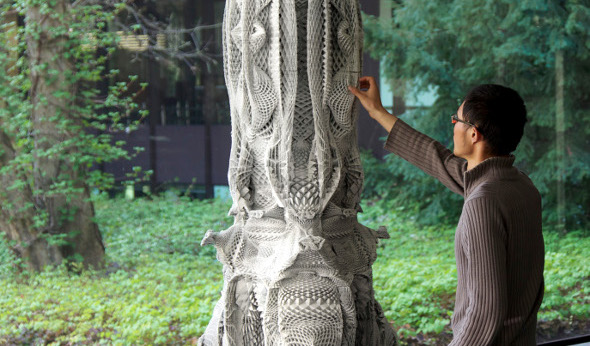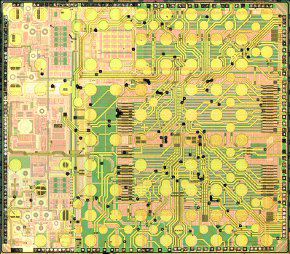Digital Architectonics
Prof. Dr. Ludger Hovestadt

Beyond The Grid
The Chair of Digital Architectonics comprises an interdisciplinary research and development team of architects, IT experts, biologists, and philosophers all asking the same question: What's next? This can't be it.
As reasonably well-informed scientists and entrepreneurs, we find ourselves in a curious position: here we are, in prosperous Switzerland, fascinated yet increasingly puzzled by the powerful global rhetoric all around us. There is Francis Fukuyama, for example, postulating the end of history, while elsewhere Immanuel Wallerstein cultivates a world-systems analysis with considerable political clout and conjures up quick fixes for nation building. In the mean time, everybody is grappling with financial and environmental crises and massive conferences are being held in the hope of tackling issues of global importance.
"Complexity" has become a buzzword that turns up everywhere these days; in most cases inappropriately, blandly nesting new potentials within an old style of discourse.
Analytics’ modernist promise of a better understanding through increased specialization and of higher security through greater control does not seem to be borne out. Quite the opposite: we bluntly reduce complex relationships to simple but politically compelling formulas, such as those concerning CO2, and in doing so, seriously undermine our own intellectual capacity. New regimes, determined by research into sustainability, are turning into an apparatus that has taken on a momentum of its own as it boxes our intellectual energies into uniform categories. Yet orientating ourselves towards hypothetical limitations, which have been worked out on the basis of computer simulations, represents a short circuit in our thinking that we should not seriously wish to expose ourselves to.
We, too, take a global perspective: our chair holds talks in India, maintains cooperations in China, has an annex in Singapore, and visits places all over the world such as Mexico City, Manila, and Addis Abeba. For several years now we have been conducting MSc programs for Applied Information Technology in Architecture that have been attended to date by students from 43 countries. We share the widespread concern about our planet’s fragility, but we take the rare view that our problem is rooted in the fact that, by and large, computers are conceived, used, and assessed simply as machines rather than as dynamic, "intelligent" tools that can help us invent, create, and imagine.
Our planet has become too small for the approximately 100 billion computer machines in use today. While they all need to be fed with data and programming so as to be able to illustrate, in a strictly analytical form, abstract scenarios of strategic thinking about the future, any picture that these scenarios might yield is applicable only insofar as it positions itself within the differentiation provided by our own capacity to pose hypotheses and generate models. However, in our overemphasis of these complimentary approaches, we've gotten ourselves trapped in an accelerating feedback loop of our own limited thinking patterns. Given all this digitally conveyed pressure to determine reality, we subject our imagination to the dictates of entropic, naturalizing analytics.
The Unloved Plateau
One of the big questions posing itself at present is whether the usual theories really do fall so short of our technical possibilities. For more than a hundred years now, we have found ourselves on an obviously very unpopular technical and cultural plateau: we now regularly conceive what just a short time ago was inconceivable. The most obvious and familiar example of this is electricity – it plays a fundamental role in contemporary urban life, but nevertheless remains completely unintuitive to us. In order to grasp and comprehend it we reduce it to a kind of smoke-free campfire, and in so doing, blind ourselves to its potential. In a similar vein, current information technologies are equally unintuitive to us because they build on the characteristic properties and uncertainties of quantum physics. And yet their technological integration is now making it possible for anyone anywhere to communicate with anyone else, no matter where on earth either of them happens to be, without wires – a seemingly inconceivable phenomenon that feels perfectly natural in the experiencing of it.
As architects we are interested in how we can go beyond the conventional reductionist approach to analytics and be guided much more by our imaginations. Our chair is driven by a curiosity about the new potentialities that information technology provides: not because we are oblivious to the urgent problems we face, but because we are convinced that what we need to do is learn to formulate these problems in a way that corresponds to our technological possibilities. Once we come to distinguish the way we deal with information technology from the way we handle mechanical apparatus and machinery, we will be able to use it to find solutions that bypass problems as they appear in their analytical formulations. In so doing, we will further cultivate and differentiate our rich cultural heritage. Thus, the networks emerging today, as topologically calculable as they are, may unleash a dynamic similar to that experienced during the Renaissance, when analytical geometry and visual perspective came to the fore.
New Narratives for Cultivating Global Networks
Our chair operates from a uniquely independent position. Our approach is interdisciplinary and we are financially secure over the long term. We have a substantial technological background: we’ve conducted over a hundred experiments in the past ten years that explore the application-orientated potential of information technology, and we have been able to successfully implement our findings in numerous technology startups (an overview of this work can be found in Beyond the Grid: Architecture and Information Technology, Birkhäuser 2009). Now we are asking: What's next?
On the new plateau, it is no longer methodological clarity, but rather literal immeasurability that counts. And learning to deal with it requires great imagination. Beyond the assumedly safe grounds of analytical clarity, we now have to acquire a degree of modesty in order to be able to think globally. The challenge is to not simply apply new technologies, but also learn how to think with them, cultivate such thinking, employ it to develop new applications and products, and to propose a new drive for our globally networked, post-digital world.
The increasingly stable and diverse stratification, in terms of information technology, of our political, economical, cultural, and architectural environments represents a particularly nonterritorial substrate. More and more, we find architectural infrastructures enmeshed in these multifarious sediments and infused with their equally multifarious symbolic manifestations. Technical infrastructures are losing their purely functional neutrality and becoming, in a sense, narrative or scenographic.
As we develop our thinking about digital construction beyond the grid, these changes are likely to play a crucial part, forming, as they do, the conception of a “new”, a “digital” or “computer-generated” architecture.
